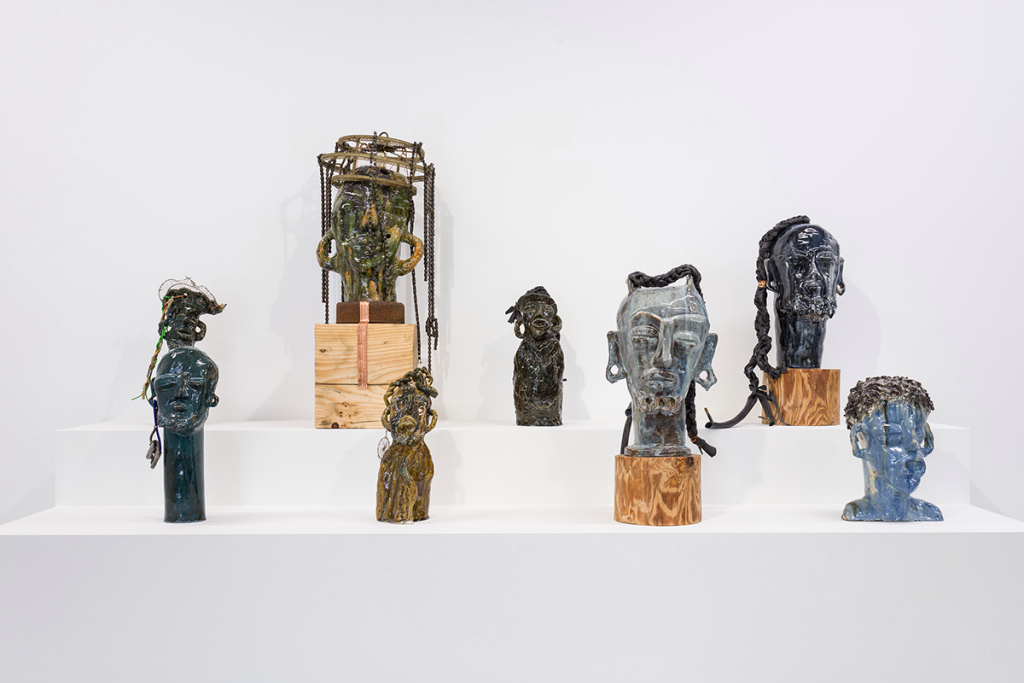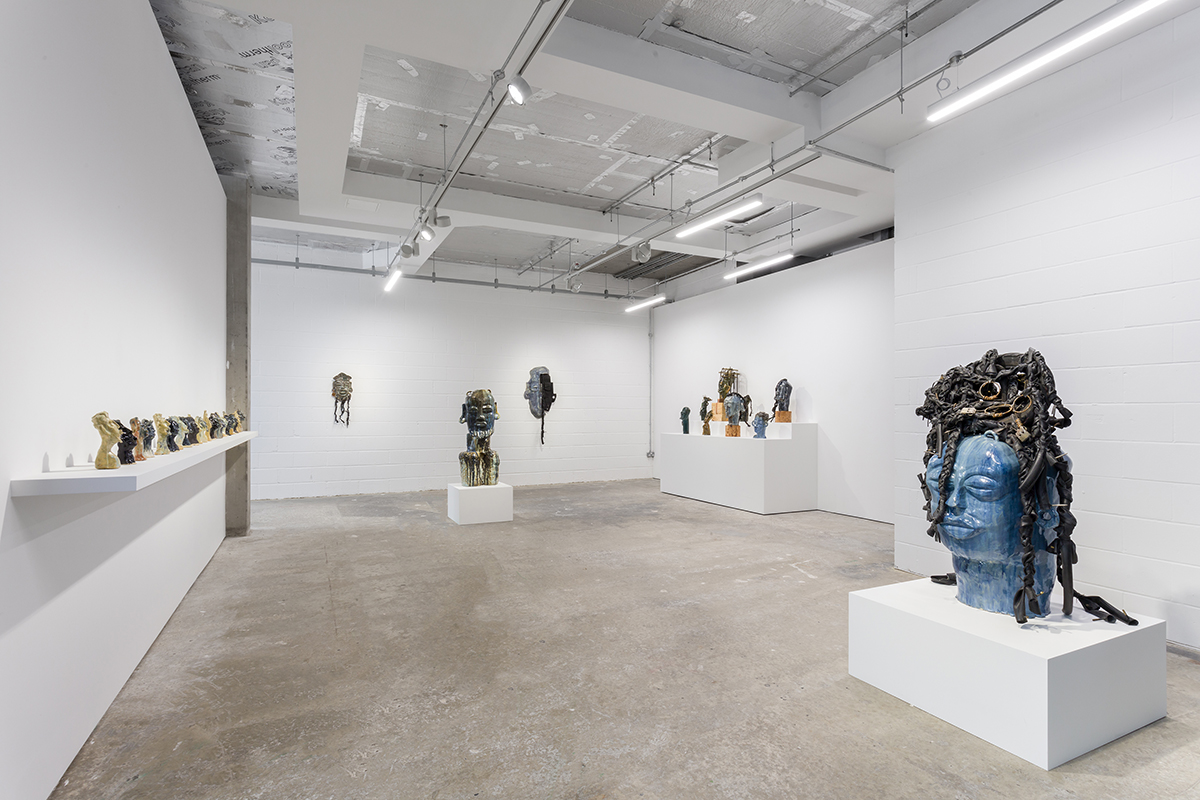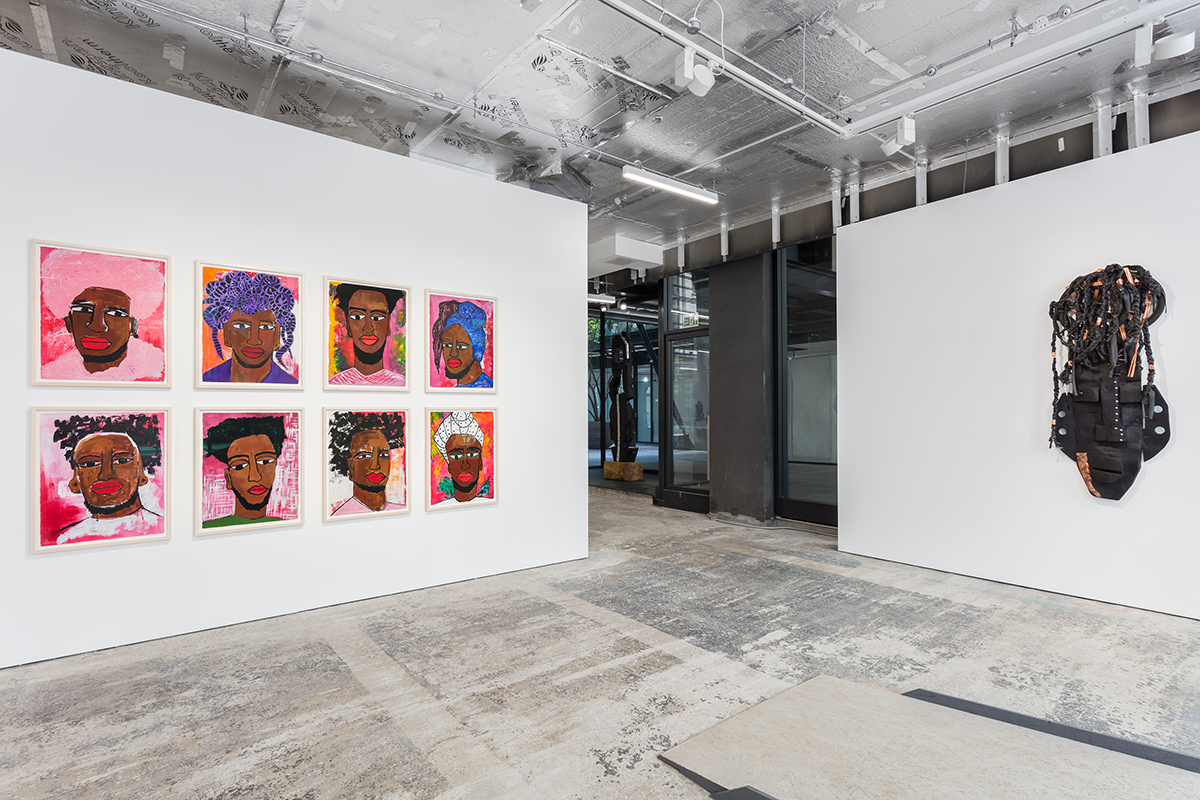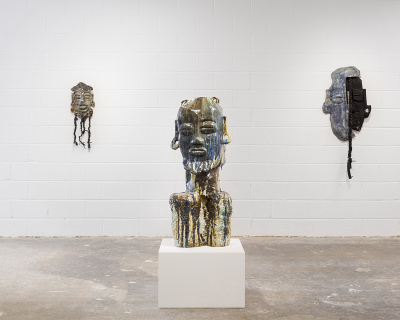 View of the exhibition “Ebika Bya ba Kuchu mu Buganda (Kuchu Clans of Buganda) II” at Stephen Friedman Gallery, London. © Leilah Babirye. Courtesy the artist, Stephen Friedman Gallery, London, and Gordon Robichaux, New York. Photo Mark Blower
View of the exhibition “Ebika Bya ba Kuchu mu Buganda (Kuchu Clans of Buganda) II” at Stephen Friedman Gallery, London. © Leilah Babirye. Courtesy the artist, Stephen Friedman Gallery, London, and Gordon Robichaux, New York. Photo Mark Blower
Uganda-born, New York-based artist Leilah Babirye examines history and clan hierarchy in the kingdom of Buganda, a Bantu enclave within Uganda, as well as the legacy of British colonialism in her home country. Her large-scale ceramic pieces, wooden sculptures, masks, drawings, and paintings on paper—all incorporating found materials—grapple with LGBTQ history, while reclaiming the Ugandan historical narrative and cultural traditions. Faces made in ceramic appear to have been poured with layers of glaze and, often, their hair is made from materials such as bicycle chains and strips of rubber from tires. Colorfully painted acrylic busts hang on the gallery wall, while small ceramic figurines stand guard on a nearby shelf. In 2015, after being publicly outed in a local newspaper, Babirye fled Uganda (where, due to British oversight, being gay has been against the law since 1902) and, in 2018, received asylum in the United States. Below, the artist discusses the power of reclaiming one’s personal identity and cultural identity. “Ebika Bya ba Kuchu mu Buganda (Kuchu Clans of Buganda) II” is on view at Stephen Friedman Gallery in London through July 31.
I had an issue with my travel documents, and I still have not been able to see the exhibition. The whole show was installed by video. I worked together with the gallery staff to place the works, and then they took me through the details to make sure everything was set before the opening.
I had more time to produce work than I had originally anticipated, because the show kept being postponed due to Covid-19. I was given the dimensions of the space, and it was important to me to see how much work I could fit in the gallery. The work on view is a continuation of the show I had last year at Gordon Robichaux in New York.
Both the space and the titles are important to me because the work is basically a reflection on where I come from in the Buganda Kingdom and on creating a queer community. The Buganda Kingdom is one of the biggest in my home country of Uganda. The kingdom is divided into clans, and every clan has its own leaders, totems, and names. Everyone is given a clan name at birth. But those of us who came out as part of the LGBTQ community are considered shameful by our families. If your parents knew you were going to be gay, they wouldn’t have given you their names or the names from their clans.
 View of the exhibition “Ebika Bya ba Kuchu mu Buganda (Kuchu Clans of Buganda) II” at Stephen Friedman Gallery, London. © Leilah Babirye. Courtesy the artist, Stephen Friedman Gallery, London, and Gordon Robichaux, New York. Photo Mark Blower
View of the exhibition “Ebika Bya ba Kuchu mu Buganda (Kuchu Clans of Buganda) II” at Stephen Friedman Gallery, London. © Leilah Babirye. Courtesy the artist, Stephen Friedman Gallery, London, and Gordon Robichaux, New York. Photo Mark Blower  View of the exhibition “Ebika Bya ba Kuchu mu Buganda (Kuchu Clans of Buganda) II” at Stephen Friedman Gallery, London. © Leilah Babirye. Courtesy the artist, Stephen Friedman Gallery, London, and Gordon Robichaux, New York. Photo Mark Blower
View of the exhibition “Ebika Bya ba Kuchu mu Buganda (Kuchu Clans of Buganda) II” at Stephen Friedman Gallery, London. © Leilah Babirye. Courtesy the artist, Stephen Friedman Gallery, London, and Gordon Robichaux, New York. Photo Mark Blower
The idea behind the work is that we honor the names we were assigned at birth, because even though we didn’t live up to our family’s expectations, we are still us. I figured why not build our own community with our names and praise our identities? Because we have these names. They’re on our birth certificates and passports. And no matter how much our parents denounce us, throw us out of their families, throw us out of their houses, and stop talking to us, they cannot detach these names from us. Being that everybody has a clan they belong to, we still follow the other norms of the clan. We’ve grown up being raised to respect the clan names, our clans, and our elders.
 View of the exhibition “Ebika Bya ba Kuchu mu Buganda (Kuchu Clans of Buganda) II” at Stephen Friedman Gallery, London. © Leilah Babirye. Courtesy the artist, Stephen Friedman Gallery, London, and Gordon Robichaux, New York. Photo Mark Blower
View of the exhibition “Ebika Bya ba Kuchu mu Buganda (Kuchu Clans of Buganda) II” at Stephen Friedman Gallery, London. © Leilah Babirye. Courtesy the artist, Stephen Friedman Gallery, London, and Gordon Robichaux, New York. Photo Mark Blower
There is a total of 52 clans, and each clan has hundreds of names. So, I don’t think I will ever exhaust the names I use to title my pieces. I try to include at least one name from each clan in every body of work that I make. All the clans are named after animals and plants. For example, I come from the antelope clan and my mother comes from the lungfish clan. In my country, everyone is familiar with each clan. It’s kind of like talking about the English monarchy in the Western world. In this sense, it’s something we all know and connect with.
I use found materials in each piece. Recently, I’ve been incorporating wood from a local lumberyard that recycles the material. I also like to visit a scrapyard just a few blocks away in Brooklyn. Reusing materials is important to me, as a person who comes from a background where the LGBTQ community is looked at as trash still today. As an artist, I find beauty in using found materials to showcase and reclaim my community.
I think all the works have their own character. They are all different from each other, even down to the glaze, which kind of makes all of them unique in their own way. For this particular show, when I was creating the bigger sculptures, I got into the details of queen mothers. These pieces are named after the queen mothers, but don’t necessarily resemble them. Rather, they recall their lineage and history.
Within this history of the queen mothers and that of the Buganda royal family, there is so much ceremony and drama, and the grooming process begins at a young age. Yet, historically speaking, there are people in the royal family who today would be considered queer. King Mwonga II, for example, is said to have been an openly bisexual king. It wasn’t a problem when mothers would train their sons to be lovers of the King. And they were given names according to how they served the king. This went on for centuries, and it wasn’t until very recently in our history that being gay was a problem.
— As told to Francesca Aton
Source link : https://www.artnews.com/art-in-america/interviews/leilah-babirye-interview-reclaiming-queer-community-stephen-friedman-1234600184












